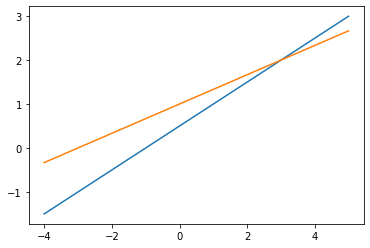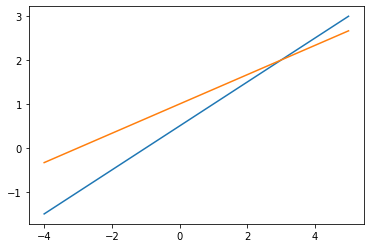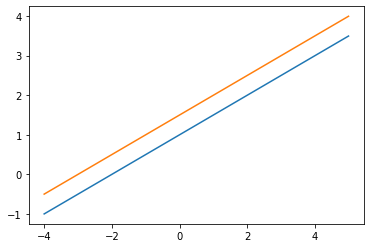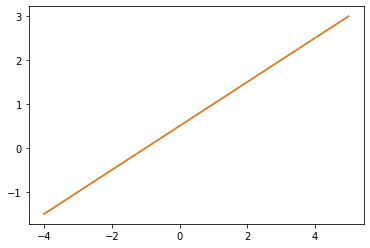利用Python学习线性代数 -- 1.1 线性方程组
利用Python学习线性代数 -- 1.1 线性方程组
本节实现的主要功能函数,在源码文件linear_system中,后续章节将作为基本功能调用。
线性方程
线性方程组由一个或多个线性方程组成,如
x_1 - 2 x_2 &= -1\\
-x_1 + 3 x_2 &= 3
\end{array}
\]
求包含两个变量两个线性方程的方程组的解,等价于求两条直线的交点。
这里可以画出书图1-1和1-2的线性方程组的图形。
通过改变线性方程的参数,观察图形,体会两个方程对应直线平行、相交、重合三种可能。
那么,怎么画二元线性方程的直线呢?
方法是这样的:
假如方程是 \(a x_1 + b x_2 = c\) 的形式,可以写成 \(x_2 = (c - a x_1) / b\)。
在以 \(x_1\) 和\(x_2\)为两个轴的直角坐标系中,\(x_1\)取一组值,如 \((-3, -2.9, -2.8, \dots, 2.9, 3.0)\),
计算相应的 \(x_2\),然后把所有点 \((x_1, x_2)\) 连起来成为一条线。
当 \(b\) 为 \(0\) 时, 则在\(x_1 = c / a\)处画一条垂直线。
# 引入Numpy和 Matplotlib库
import numpy as np
from matplotlib import pyplot as plt
Matplotlib 是Python中使用较多的可视化库,这里只用到了它的一些基本功能。
def draw_line(a, b, c, start=-4,
stop=5, step=0.01):
"""根据线性方程参数绘制一条直线"""
# 如果b为0,则画一条垂线
if np.isclose(b, 0):
plt.vlines(start, stop, c / a)
else: # 否则画 y = (c - a*x) / b
xs = np.arange(start, stop, step)
plt.plot(xs, (c - a*xs)/b)
# 1.1 图1-1
draw_line(1, -2, -1)
draw_line(-1, 3, 3)

def draw_lines(augmented, start=-4,
stop=5, step=0.01):
"""给定增广矩阵,画两条线."""
plt.figure()
for equation in augmented:
draw_line(*equation, start, stop, step)
plt.show()
# Fig. 1-1
# 增广矩阵用二维数组表示
# [[1, -2, -1], [-1, 3, 3]]
# 这些数字对应图1-1对应方程的各项系数
draw_lines([[1, -2, -1], [-1, 3, 3]])

# Fig. 1-2
draw_lines([[1, -2, -2], [-1, 2, 3]])
# Fig. 1-3
draw_lines([[1, -2, -1], [-1, 2, 1]])


- 建议:改变这些系数,观察直线,体会两条直线相交、平行和重合的情况
例如
draw_lines([[1, -2, -2], [-1, 2, 9]])
如果对Numpy比较熟悉,则可以采用更简洁的方式实现上述绘图功能。
在计算多条直线方程时,可以利用向量编程的方式,用更少的代码实现。
def draw_lines(augmented, start=-4,
stop=5, step=0.01):
"""Draw lines represented by augmented matrix on 2-d plane."""
am = np.asarray(augmented)
xs = np.arange(start, stop, step).reshape([1, -1])
# 同时计算两条直线的y值
ys = (am[:, [-1]] - am[:, [1]]*xs) / am[:, [0]]
for y in ys:
plt.plot(xs[0], y)
plt.show()
矩阵记号
矩阵是一个数表,在程序中通常用二维数组表示,例如
# 嵌套列表表示矩阵
matrix = [[1, -2, 1, 0],
[0, 2, -8, 8],
[5, 0, -5, 10]]
matrix
[[1, -2, 1, 0], [0, 2, -8, 8], [5, 0, -5, 10]]
实际工程和研究实践中,往往会采用一些专门的数值计算库,简化和加速计算。
Numpy库是Python中数值计算的常用库。
在Numpy中,多维数组类型称为ndarray,可以理解为n dimensional array。
例如
# Numpy ndarray 表示矩阵
matrix = np.array([[1, -2, 1, 0],
[0, 2, -8, 8],
[5, 0, -5, 10]])
matrix
array([[ 1, -2, 1, 0],
[ 0, 2, -8, 8],
[ 5, 0, -5, 10]])
解线性方程组
本节解线性方程组的方法是 高斯消元法,利用了三种基本行变换。
- 把某个方程换成它与另一个方程的倍数的和;
- 交换两个方程的位置;
- 某个方程的所有项乘以一个非零项。
假设线性方程的增广矩阵是\(A\),其第\(i\)行\(j\)列的元素是\(a_{ij}\)。
消元法的基本步骤是:
- 增广矩阵中有 \(n\) 行,该方法的每一步处理一行。
- 在第\(i\)步,该方法处理第\(i\)行
- 若\(a_{ii}\)为0,则在剩余行 \(\{j| j \in (i, n]\}\)中选择绝对值最大的行\(a_{ij}\)
- 若\(a_{ij}\)为0,返回第1步。
- 否则利用变换2,交换\(A\)的第\(i\)和\(j\)行。
- 若\(a_{ii}\)为0,则在剩余行 \(\{j| j \in (i, n]\}\)中选择绝对值最大的行\(a_{ij}\)
- 利用行变换3,第\(i\)行所有元素除以\(a_{ii}\),使第 \(i\) 个方程的第 \(i\)个 系数为1
- 利用行变换1,\(i\)之后的行减去第\(i\)行的倍数,使这些行的第 \(i\) 列为0
- 在第\(i\)步,该方法处理第\(i\)行
为了理解这些步骤的实现,这里先按书中的例1一步步计算和展示,然后再总结成完整的函数。
例1的增广矩阵是
\begin{array}
&1 & -2 & 1 & 0\\
0 & 2 & -8 & 8\\
5 & 0 & -5 & 10
\end{array}
\right]
\]
# 增广矩阵
A = np.array([[1, -2, 1, 0],
[0, 2, -8, 8],
[5, 0, -5, 10]])
# 行号从0开始,处理第0行
i = 0
# 利用变换3,将第i行的 a_ii 转成1。这里a_00已经是1,所不用动
# 然后利用变换1,把第1行第0列,第2行第0列都减成0。
# 这里仅需考虑i列之后的元素,因为i列之前的元素已经是0
# 即第1行减去第0行的0倍
# 而第2行减去第0行的5倍
A[i+1:, i:] = A[i+1:, i:] - A[i+1:, [i]] * A[i, i:]
A
array([[ 1, -2, 1, 0],
[ 0, 2, -8, 8],
[ 0, 10, -10, 10]])
i = 1
# 利用变换3,将第i行的 a_ii 转成1。
A[i] = A[i] / A[i, i]
A
array([[ 1, -2, 1, 0],
[ 0, 1, -4, 4],
[ 0, 10, -10, 10]])
# 然后利用变换1,把第2行第i列减成0。
A[i+1:, i:] = A[i+1:, i:] - A[i+1:, [i]] * A[i, i:]
A
array([[ 1, -2, 1, 0],
[ 0, 1, -4, 4],
[ 0, 0, 30, -30]])
i = 2
# 利用变换3,将第i行的 a_ii 转成1。
A[i] = A[i] / A[i, i]
A
array([[ 1, -2, 1, 0],
[ 0, 1, -4, 4],
[ 0, 0, 1, -1]])
消元法的前向过程就结束了,我们可以总结成一个函数
def eliminate_forward(augmented):
"""
消元法的前向过程.
返回行阶梯形,以及先导元素的坐标(主元位置)
"""
A = np.asarray(augmented, dtype=np.float64)
# row number of the last row
pivots = []
i, j = 0, 0
while i < A.shape[0] and j < A.shape[1]:
A[i] = A[i] / A[i, j]
if (i + 1) < A.shape[0]: # 除最后一行外
A[i+1:, j:] = A[i+1:, j:] - A[i+1:, [j]] * A[i, j:]
pivots.append((i, j))
i += 1
j += 1
return A, pivots
这里有两个细节值得注意
- 先导元素 \(a_{ij}\),不一定是在主对角线位置,即 \(i\) 不一定等于\(j\).
- 最后一行只需要用变换3把先导元素转为1,没有剩余行需要转换
# 测试一个增广矩阵,例1
A = np.array([[1, -2, 1, 0],
[0, 2, -8, 8],
[5, 0, -5, 10]])
A, pivots = eliminate_forward(A)
print(A)
print(pivots)
[[ 1. -2. 1. 0.]
[ 0. 1. -4. 4.]
[ 0. 0. 1. -1.]]
[(0, 0), (1, 1), (2, 2)]
消元法的后向过程则更简单一些,对于每一个主元(这里就是前面的\(a_{ii}\)),将其所在的列都用变换1,使其它行对应的列为0.
for i, j in reversed(pivots):
A[:i, j:] = A[:i, j:] - A[[i], j:] * A[:i, [j]]
A
array([[ 1., 0., 0., 1.],
[ 0., 1., 0., 0.],
[ 0., 0., 1., -1.]])
def eliminate_backward(simplified, pivots):
"""消元法的后向过程."""
A = np.asarray(simplified)
for i, j in reversed(pivots):
A[:i, j:] = A[:i, j:] - A[[i], j:] * A[:i, [j]]
return A
至此,结合 eliminate_forward 和eliminate_backward函数,可以解形如例1的线性方程。
然而,存在如例3的线性方程,在eliminate_forward算法进行的某一步,主元为0,需要利用变换2交换两行。
交换行时,可以选择剩余行中,选择当前主元列不为0的任意行,与当前行交换。
这里每次都采用剩余行中,当前主元列绝对值最大的行。
补上行交换的前向过程函数如下
def eliminate_forward(augmented):
"""消元法的前向过程"""
A = np.asarray(augmented, dtype=np.float64)
# row number of the last row
pivots = []
i, j = 0, 0
while i < A.shape[0] and j < A.shape[1]:
# if pivot is zero, exchange rows
if np.isclose(A[i, j], 0):
if (i + 1) < A.shape[0]:
max_k = i + 1 + np.argmax(np.abs(A[i+1:, i]))
if (i + 1) >= A.shape[0] or np.isclose(A[max_k, i], 0):
j += 1
continue
A[[i, max_k]] = A[[max_k, i]]
A[i] = A[i] / A[i, j]
if (i + 1) < A.shape[0]:
A[i+1:, j:] = A[i+1:, j:] - A[i+1:, [j]] * A[i, j:]
pivots.append((i, j))
i += 1
j += 1
return A, pivots
行交换时,有一种特殊情况,即剩余所有行的主元列都没有非零元素。
这种情况下,在当前列的右侧寻找不为零的列,作为新的主元列。
# 用例3测试eliminate_forward
aug = [[0, 1, -4, 8],
[2, -3, 2, 1],
[4, -8, 12, 1]]
echelon, pivots = eliminate_forward(aug)
print(echelon)
print(pivots)
[[ 1. -2. 3. 0.25]
[ 0. 1. -4. 0.5 ]
[ 0. 0. 0. 1. ]]
[(0, 0), (1, 1), (2, 3)]
例3化简的结果与书上略有不同,由行交换策略不同引起,也说明同一个矩阵可能由多个阶梯形。
结合上述的前向和后向过程,即可以给出一个完整的消元法实现
def eliminate(augmented):
"""
利用消元法前向和后向步骤,化简线性方程组.
如果是矛盾方程组,则仅输出前向化简结果,并打印提示
否则输出简化后的方程组,并输出最后一列
"""
print(np.asarray(augmented))
A, pivots = eliminate_forward(augmented)
print(" The echelon form is\n", A)
print(" The pivots are: ", pivots)
pivot_cols = {p[1] for p in pivots}
simplified = eliminate_backward(A, pivots)
if (A.shape[1]-1) in pivot_cols:
print(" There is controdictory.\n", simplified)
elif len(pivots) == (A.shape[1] -1):
print(" Solution: ", simplified[:, -1])
is_correct = solution_check(np.asarray(augmented),
simplified[:, -1])
print(" Is the solution correct? ", is_correct)
else:
print(" There are free variables.\n", simplified)
print("-"*30)
eliminate(aug)
[[ 0 1 -4 8]
[ 2 -3 2 1]
[ 4 -8 12 1]]
The echelon form is
[[ 1. -2. 3. 0.25]
[ 0. 1. -4. 0.5 ]
[ 0. 0. 0. 1. ]]
The pivots are: [(0, 0), (1, 1), (2, 3)]
There is controdictory.
[[ 1. 0. -5. 0.]
[ 0. 1. -4. 0.]
[ 0. 0. 0. 1.]]
------------------------------
利用 Sympy 验证消元法实现的正确性
Python的符号计算库Sympy,有化简矩阵为行最简型的方法,可以用来检验本节实现的代码是否正确。
# 导入 sympy的 Matrix模块
from sympy import Matrix
Matrix(aug).rref(simplify=True)
# 返回的是行最简型和主元列的位置
(Matrix([
[1, 0, -5, 0],
[0, 1, -4, 0],
[0, 0, 0, 1]]), (0, 1, 3))
echelon, pivots = eliminate_forward(aug)
simplified = eliminate_backward(echelon, pivots)
print(simplified, pivots)
# 输出与上述rref一致
[[ 1. 0. -5. 0.]
[ 0. 1. -4. 0.]
[ 0. 0. 0. 1.]] [(0, 0), (1, 1), (2, 3)]
综合前向和后向步骤,并结果的正确性
综合前向和后向消元,就可以得到完整的消元法过程。
消元结束,如果没有矛盾(最后一列不是主元列),基本变量数与未知数个数一致,则有唯一解,可以验证解是否正确。
验证的方法是将解与系数矩阵相乘,检查与原方程的b列一致。
def solution_check(augmented, solution):
# 系数矩阵与解相乘
b = augmented[:, :-1] @ solution.reshape([-1, 1])
b = b.reshape([-1])
# 检查乘积向量与b列一致
return all(np.isclose(b - augmented[:, -1], np.zeros(len(b))))
def eliminate(augmented):
from sympy import Matrix
print(np.asarray(augmented))
A, pivots = eliminate_forward(augmented)
print(" The echelon form is\n", A)
print(" The pivots are: ", pivots)
pivot_cols = {p[1] for p in pivots}
simplified = eliminate_backward(A, pivots)
if (A.shape[1]-1) in pivot_cols: # 最后一列是主元列
print(" There is controdictory.\n", simplified)
elif len(pivots) == (A.shape[1] -1): # 唯一解
is_correct = solution_check(np.asarray(augmented),
simplified[:, -1])
print(" Is the solution correct? ", is_correct)
print(" Solution: \n", simplified)
else: # 有自由变量
print(" There are free variables.\n", simplified)
print("-"*30)
print("对比Sympy的rref结果")
print(Matrix(augmented).rref(simplify=True))
print("-"*30)
测试书中的例子
aug_1_1_1 = [[1, -2, 1, 0],
[0, 2, -8, 8],
[5, 0, -5, 10]]
eliminate(aug_1_1_1)
# 1.1 example 3
aug_1_1_3 = [[0, 1, -4, 8],
[2, -3, 2, 1],
[4, -8, 12, 1]]
eliminate(aug_1_1_3)
eliminate([[1, -6, 4, 0, -1],
[0, 2, -7, 0, 4],
[0, 0, 1, 2, -3],
[0, 0, 3, 1, 6]])
eliminate([[0, -3, -6, 4, 9],
[-1, -2, -1, 3, 1],
[-2, -3, 0, 3, -1],
[1, 4, 5, -9, -7]])
eliminate([[0, 3, -6, 6, 4, -5],
[3, -7, 8, -5, 8, 9],
[3, -9, 12, -9, 6, 15]])
[[ 1 -2 1 0]
[ 0 2 -8 8]
[ 5 0 -5 10]]
The echelon form is
[[ 1. -2. 1. 0.]
[ 0. 1. -4. 4.]
[ 0. 0. 1. -1.]]
The pivots are: [(0, 0), (1, 1), (2, 2)]
Is the solution correct? True
Solution:
[[ 1. 0. 0. 1.]
[ 0. 1. 0. 0.]
[ 0. 0. 1. -1.]]
------------------------------
对比Sympy的rref结果
(Matrix([
[1, 0, 0, 1],
[0, 1, 0, 0],
[0, 0, 1, -1]]), (0, 1, 2))
------------------------------
[[ 0 1 -4 8]
[ 2 -3 2 1]
[ 4 -8 12 1]]
The echelon form is
[[ 1. -2. 3. 0.25]
[ 0. 1. -4. 0.5 ]
[ 0. 0. 0. 1. ]]
The pivots are: [(0, 0), (1, 1), (2, 3)]
There is controdictory.
[[ 1. 0. -5. 0.]
[ 0. 1. -4. 0.]
[ 0. 0. 0. 1.]]
------------------------------
对比Sympy的rref结果
(Matrix([
[1, 0, -5, 0],
[0, 1, -4, 0],
[0, 0, 0, 1]]), (0, 1, 3))
------------------------------
[[ 1 -6 4 0 -1]
[ 0 2 -7 0 4]
[ 0 0 1 2 -3]
[ 0 0 3 1 6]]
The echelon form is
[[ 1. -6. 4. 0. -1. ]
[ 0. 1. -3.5 0. 2. ]
[ 0. 0. 1. 2. -3. ]
[-0. -0. -0. 1. -3. ]]
The pivots are: [(0, 0), (1, 1), (2, 2), (3, 3)]
Is the solution correct? True
Solution:
[[ 1. 0. 0. 0. 62. ]
[ 0. 1. 0. 0. 12.5]
[ 0. 0. 1. 0. 3. ]
[-0. -0. -0. 1. -3. ]]
------------------------------
对比Sympy的rref结果
(Matrix([
[1, 0, 0, 0, 62],
[0, 1, 0, 0, 25/2],
[0, 0, 1, 0, 3],
[0, 0, 0, 1, -3]]), (0, 1, 2, 3))
------------------------------
[[ 0 -3 -6 4 9]
[-1 -2 -1 3 1]
[-2 -3 0 3 -1]
[ 1 4 5 -9 -7]]
The echelon form is
[[ 1. 1.5 -0. -1.5 0.5]
[-0. 1. 2. -3. -3. ]
[-0. -0. -0. 1. -0. ]
[ 0. 0. 0. 0. 0. ]]
The pivots are: [(0, 0), (1, 1), (2, 3)]
There are free variables.
[[ 1. 0. -3. 0. 5.]
[-0. 1. 2. 0. -3.]
[-0. -0. -0. 1. -0.]
[ 0. 0. 0. 0. 0.]]
------------------------------
对比Sympy的rref结果
(Matrix([
[1, 0, -3, 0, 5],
[0, 1, 2, 0, -3],
[0, 0, 0, 1, 0],
[0, 0, 0, 0, 0]]), (0, 1, 3))
------------------------------
[[ 0 3 -6 6 4 -5]
[ 3 -7 8 -5 8 9]
[ 3 -9 12 -9 6 15]]
The echelon form is
[[ 1. -2.33333333 2.66666667 -1.66666667 2.66666667 3. ]
[ 0. 1. -2. 2. 1.33333333 -1.66666667]
[ 0. 0. 0. 0. 1. 4. ]]
The pivots are: [(0, 0), (1, 1), (2, 4)]
There are free variables.
[[ 1. 0. -2. 3. 0. -24.]
[ 0. 1. -2. 2. 0. -7.]
[ 0. 0. 0. 0. 1. 4.]]
------------------------------
对比Sympy的rref结果
(Matrix([
[1, 0, -2, 3, 0, -24],
[0, 1, -2, 2, 0, -7],
[0, 0, 0, 0, 1, 4]]), (0, 1, 4))
------------------------------最新文章
- Jquery事件:鼠标移入移出(mouseenter,mouseleave)
- C#小程序呢飞行棋设计分析
- BestCoder Round #61 1001 Numbers
- 1个简单的Log
- PHP编译支持mysqli
- SSH自定义分页标签
- asp.net下ajax.ajaxMethod使用方法(转)
- c++ 观察者模式
- perl静态编译DBD
- T-SQL函数及用法--转
- java.lang.ClassNotFoundException: org.apache.commons.pool2.impl.GenericObjectPoolConfig
- 软硬件协同编程 - C#玩转CPU高速缓存(附示例)
- 几个C++ online test 网站
- Java里的String类为什么是final的
- learning scala 数组和容器
- java8 快速入门 lambda表达式 Java8 lambda表达式10个示例
- SpringMVC------maven编译报错:Dynamic Web Module 3.0 requires Java 1.6 or newer
- VUE 学习笔记 四 计算属性和监听器
- [SharePoint 2010]Sandboxed Solution (沙箱解決方案)
- SkipList 之详细分析
热门文章
- Knative 实战:基于 Kafka 实现消息推送
- docker3-镜像的使用
- ESP8266开发之旅 网络篇⑯ 无线更新——OTA固件更新
- netty源码解析(4.0)-26 ByteBuf内存池:PoolArena-PoolSubpage
- Spring Cloud Alibaba学习笔记(23) - 调用链监控工具Spring Cloud Sleuth + Zipkin
- 数据结构(三十二)图的遍历(DFS、BFS)
- [2018-08-03] python开发个人资源共享网--第一天
- Map Reduce 论文阅读
- *args和**kwargs的作用
- day 1 晚上 P2824 [HEOI2016/TJOI2016]排序 线段树